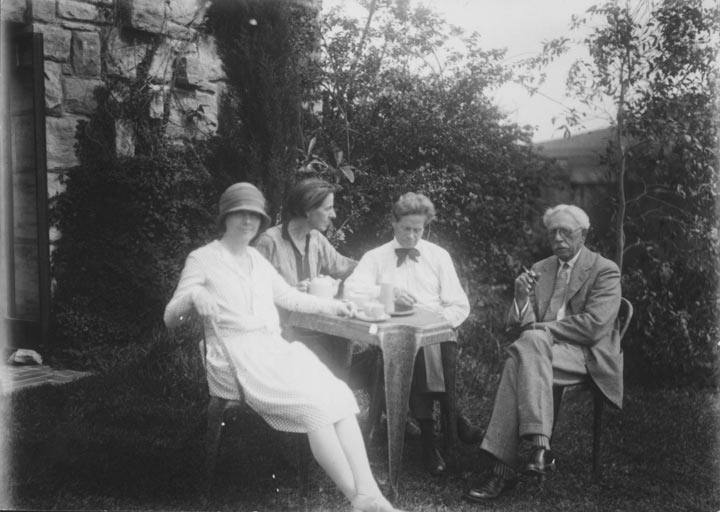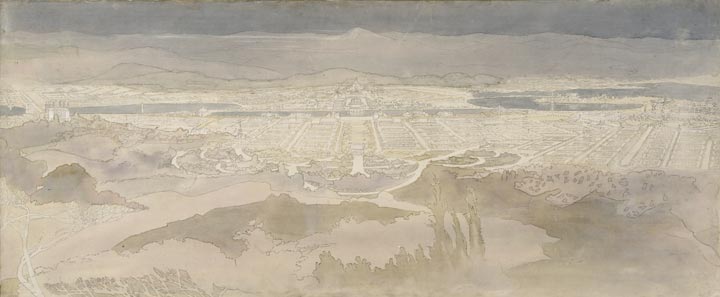‘I don’t talk about Griffin in the twenties or the thirties, I talk about the Griffins.’
‘Always there was this … often silent communication between them. There was a kind of fusion. And you would hear them expressing the same ideas, the same philosophical ideas, but coming at them from a different angle’
A new appreciation
A central feature of new interest in the lives and achievements of the Griffins is the realisation that Walter Burley Griffin and Marion Mahony Griffin were an exceptional team.
To an audience in the twenty-first century the Griffins were, in Professor James Weirick’s words, a ‘marvellous team’; considerably more together than the sum of their individual parts. However for most of the twentieth century the shared nature of the Griffins’ work could not be fully appreciated because, within the professional tradition of architecture, their joint achievement could be culturally coherent only if Walter Griffin was understood to own the work. The established tradition of architect-as-author lacked a convincing discourse of professional collaboration which could legitimate Marion Mahony’s role, and generate convincing evidence of her achievement, save as a remarkable ‘helper’.
But by the end of the twentieth century, as interest in both Marion Mahony and Walter Griffin widened beyond the frame of architecture, their shared achievement could be better understood. This is no more effectively measured than in the placement of the apostrophe. What was formerly described as Griffin’s (meaning Walter Griffin’s) work became generally described as the Griffins’ work.
A combination of talents
According to Professor James Weirick (Weirick, 1998) the Griffins found a way ‘to revitalise their creativity and energy, to recharge the “authority from within” which was the essence of their life philosophy.’ Dr Jeffrey Turnbull has described the rare nature of their partnership saying that there are ‘certain things that she brings to that collaboration from her enthusiasm and knowledge. And of course he (Walter Griffin) has his own experiences and ideals, and they combine wonderfully to produce Griffin architecture. I never separate them now,’ he says. ‘I don’t talk about Griffin in the twenties or the thirties, I talk about the Griffins.’ (Turnbull, City of Dreams 2000)
Turnbull describes their collaboration in the Castlecrag years: ‘Marion would do a perspective drawing of the site and they would sit there together, looking at this perspective … trying to discover from which part of the site the house would seem to want to grow.’ Wanda Spathopoulus, who grew up in Castlecrag, remembers the collaboration clearly. She says, ‘Always there was this … often silent communication between them. There was a kind of fusion. And you would hear them expressing the same ideas, the same philosophical ideas, but coming at them from a different angle’ (Spathopoulus, City of Dreams 2000).
Within Marion Mahony’s value system (informed by Steiner’s anthroposophy) any claim of authorship would have been beside the point. Rarely did either of them try to clarify which bits of the work were Marion Mahony’s and which were Walter Griffin’s. Ownership in this sense was awarded by others. Marion Mahony’s images affected a plan — in its drawn, as well as its built form — because, as Weirick says, her images ‘heighten our awareness and understanding’ of a building’s meaning and potential (Weirick, 1998).
Marion Mahony’s artistry
In Australia, the designs for Canberra and the Sydney suburb of Castlecrag have been central to the reputations of both Marion Mahony and Walter Griffin. The connection between Canberra and the Griffin name became fused in the Australian imagination when Marion Mahony’s renderings of the plan became recognisable at the end of the twentieth century and began to appear in a wide range of materials used to either denote, or promote, the city. While the Griffins’ plan bears little resemblance to the national capital of the present, Marion Mahony’s golden renderings maintain a strong, symbolic connection with the original design. By the end of the century it became less easy to ignore her role in the partnership.
Marion Mahony knew the value of her contribution, and the enthusiasm with which she subsumed her own creative forces to, as she says in The Magic of America, ‘make me a slave to my husband in his creative work’, was her way of being a wife within the conventions of early twentieth century life. But, perhaps more than that, it was Marion Mahony’s way of celebrating and supporting what she believed was Walter Griffin’s genius.
Author
Judy Wells is a former journalist and a lecturer in communication at the University of Newcastle (NSW). Her special interest in the Griffins began when she was living in Canberra in 1994. From material available in Canberra at that time it appeared that Marion’s role in the Griffin partnership was poorly understood and generally underestimated in the available literature. Judy’s subsequent enquiry formed the basis for her PhD research which considered how Marion’s reputation as an artist, architect and activist began to change towards the end of the twentieth century when cultural forces, beyond the discipline of architecture, began to make new sense of who Marion was and what she had achieved.
Further reading
Griffin, Marion Mahony, The Magic of America: Electronic Edition, Art Institute of Chicago, published online only, August 2007, http://www.artic.edu/magicofamerica/
Spathopoulus, Wanda, City of Dreams (documentary film).Sydney, Film Australia, 2000.
Turnbull, Jeff, City of Dreams (documentary film).Sydney, Film Australia, 2000.
Weirick, James, City of Dreams (documentary film).Sydney, Film Australia, 2000.
Weirick, James, ‘Spirituality and Symbolism in the Work of the Griffins’, in Anne Watson (ed.) Beyond architecture: Marion Mahony and Walter Burley Griffin in America, Australia, India. Sydney, Powerhouse Publishing, 1998 pp56-85.


